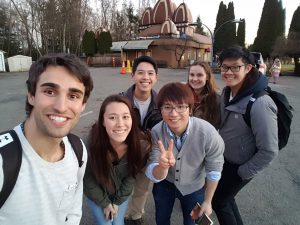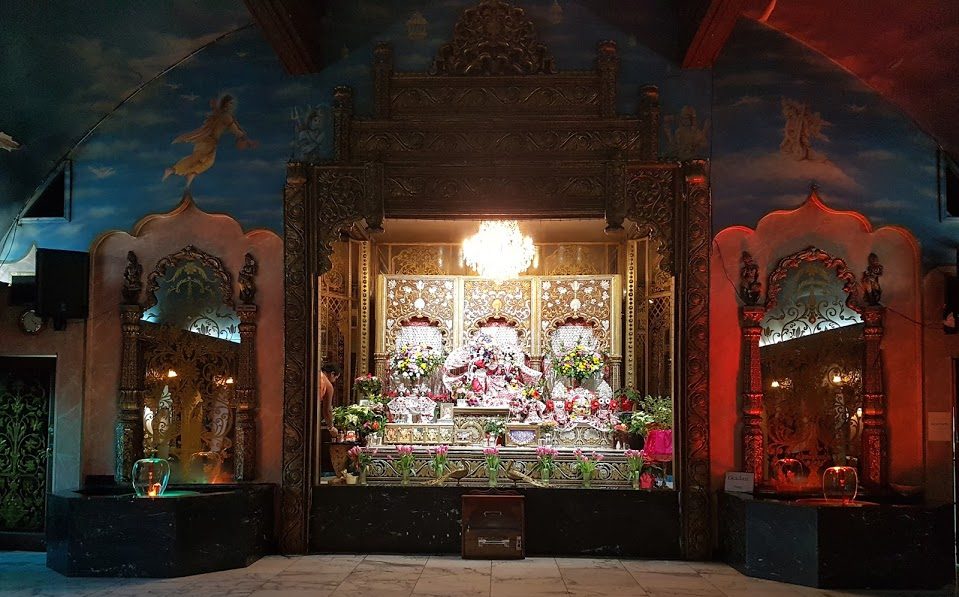Hey! Do you care about great food? How about making a positive impact in our world? Well so do we:

(from left to right: Timerlane, Sarah, Marcus, Kentaro, Alysha, Jaidan)
Welcome! This enthusiastic group is fresh back from our visit with the Hare Krishna Temple in Burnaby. While at the Temple we met community leaders Bhav and Jaya Govinda. They explained that the focus of the temple is to spread Krishna Consciousness. Which to our teams surprise directly relates to sustainability and global development. Jaya Govinda taught us the temple and its followers practice Bhakti Yoga, the yoga of love and devotion, where the practice and purpose in living is to see everything as love and as the divine and to honor it though devotion particularly through song, writing, dance, and community. In addition to Bhakti Yoga, is Jhana Yoga, the Yoga of wisdom and discernment. Bhav added, one of the core beliefs of Krishna Consciousness is the reason why the world is the way it is is because of our mindsets, in other words, because of our level of consciousness. It is suggested that as ones inner world shifts – including perceptions, values, and beliefs – so do their actions and so does our outer material world (Allen, P. 2008). The Hare Krishna movement is global and has it roots in ancient India over 6000 years ago. More recently key Yogi’s brought the Krishna movement to America in 1965.
Our team consists of three Food, Nutrition and Health Majors; Sarah, Alysha and Jaidan. All three are hoping to gain a better understanding of how nutrition relates to health aspects such as sports nutrition, global malnutrition, are affordable meal access. Kentaro, a Food Market Analysis student, has a post undergraduate goal of solving tuna over fishing caused by current farm fishing practices. The last two team members, Marcus and Timerlane, bring forward a Global Resource Systems perspective that considers how to engage people in issues of our present day in context to their own personal interests and seek to answer the bigger questions such as “how we create environments and systems which bring out the best in people.” As suggested by Phillips, K. W (2014), this beautiful diversity in our group is one of our many assets.
As a group, we have common goals and interests. We wish to open our mind to ideas and ways of being that we have never considered before. We are excited to challenge our assumptions and to support each other through the growth in this project. We each have our own unique curiosity around spirituality and we connect in knowing food is part of the essence of life which makes our bodies and world work. One of our main common interests is how culture plays a role in food choices and how different groups use food to express their spiritual beliefs. Moreover, how do faith practices influence community and the greater food system and effectively is the Krishna movement inspiring sustainability and food justice.
We are interested in what the assets of the organization are, and in which way we will be able to support them. We are looking forward to exposure to Indian cooking and meal preparation for large groups. In our first visit we felt very warm and welcomed, while afterwords we found yourself wondering if the Vancouver community perceives the Hare Krishna Temple as a welcoming place or more of a cult? Lots of questions to answer. Above all we look forward to this opportunity to connect, contribute, and grow with each other and our community partner.
Our team was largely drawn to the Hare Krishna Temple because of the intersections of faith, culture, and food. Thus we were amazed to find out The Hare Krishna Temple is part of a global network of communities gathered around service to the world and Bhakti Yoga – the yoga of love, devotion, and relation. AND food and by extension sustainability and development is central to their mission: food is life, and life is food.
The Krishna consciousness belief is that everything is sacred and that our economic, environmental, political, spiritual, communal, and social systems must support this sacredness. Some of the ways Hare Krishna Temples reach their aims are with the provision of regular free healthy vegetarian meals as well as a safe place to connect, pray, worship, sing, dance, love, rest through individuals own unique expression.

(Krishna Playing His Divine Flute in Natural Beauty)
Focusing on the assets of the Temple was eye opening (Mathie, A., & Cunningham, G. (2003), as we learned the temple is a center-piece of culture and faith for this community. Jaya Govinda informed us that the temples are not only involved locally with vegetarian meal provision, but also has acts as part of an international system. The organization is part of “eco villages” scattered throughout the globe that focus on sustainable, good karma food production methods. In addition to this, the Hare Krishna temple based in Vancouver also has rural farms towards the interior of BC that seek to provide cow protection zones and utilizes organic farming techniques to grow a wide variety of produce.
Our team was surprised to learn that this temple has its origins intertwined with the 1970’s mentality of simplicity and harmless diets for the planet and for animals. However this has inspired one of our goals for the end of the project. If it is also seen valuable by our community partner, we are interested in supporting the development of the Hare Krishna Temples community garden throughout the spring months.
Other ideas brought to life from our interactions at the Hare Krishna Temple and in Lecture with Will Valleys LFS 350 course include articulating how regional food system policy interacts with public food assets in order to promote a healthy, sustainable and just food system. We look forward to conducting an institutional case study and communicating these results back to the general public. We aspire to effectively describe the breadth of an institution/organization and how they contribute to the community food system and more importantly how food contributes to organizational objectives.
Our ideas our copious. Though we will have to focus – and our proposal is helping us do so – we would also like to figure out what kinds of foods are the most appealing to the community and how the Hare Krishna food plan at the temple could improve in the coming years. We could also navigate a way using questionnaire or surveys to improve the waste efficient and public opinion of the Hare Krishna Temple.
Our first impressions of the project have been great. We are a cohesive group that is open to embracing the asset based development approach while exploring justice, faith, and culture in our community based learning system. We are a smart and hardworking team who has enough common interest for collaboration and enough uniqueness to give us a special spark.
Our team carries with us the passion and experience from Ernesto Sirolli’s TED Talk where he draws on the significance of focusing on assets and on letting the community partner speak – while we listen – to build trust, integrity, and authenticity. For any project to be truly successful it’s key for all parties involved to brainstorm approaches, resources, criteria etc. in order to actually find the most context specific strategies (McCullum et al, 2005). For instance, by asking the temple what they think needs to happen and what resources they already have together we can co-create an effective plan to implement together that will actually benefit the community members instead of just doing what we perceive to be needed. Connecting that to the temple, it is incredibly powerful to have community. Krishna Consciousness is inherently asset based, it believes we are whole, beautiful, peaceful, loving, sacred, and divine. The movement strives to bring the best out of people starting with what people have, and building around food, community, place, spirit, love, song, story, and dance. The justice aspect functions on the principle that everyone is equal and our journey on earth has much more to do with what is happening inside in our hearts than it does on our outsides. We need to be cohesive as a group to do well in this project, just like the temple we are researching and learning from needs to be a cohesive community in order to function optimally.
Sources
Allen, P. (2008). Mining for justice in the food system: perceptions, practices, and possibilities. Agriculture and Human Values, 25(2), 157–161.
Mathie, A., & Cunningham, G. (2003). From clients to citizens: Asset-based Community Development as a strategy for community-driven development. Development in Practice, 13(5), 474–486.
McCullum, C., Desjardins, E., Kraak, V. I., Ladipo, P., & Costello, H. (2005). Evidence-based strategies to build community food security. Journal of the American Dietetic Association, 105(2), 278–283.
Phillips, K. W. (2014). How Diversity Makes Us Smarter. Retrieved August 24, 2016, from http://www.scientificamerican.com/article/how-diversity-makes-us-smarter/
